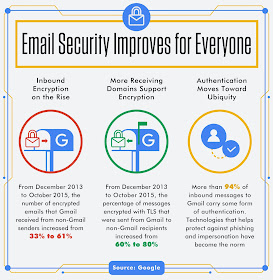We’re constantly working to help make email more secure for everyone. These efforts are reflected in security protections like default HTTPS in Gmail as well as our Safer Email Transparency report, which includes information about email security beyond just Gmail.
To that end, in partnership with the University of Michigan and the University of Illinois, we’re publishing the results of a multi-year study that measured how email security has evolved since 2013. While Gmail was the foundation of this research, the study’s insights apply to email more broadly, not unlike our Safer Email Transparency report. It’s our hope that these findings not only help make Gmail more secure, but will also be used to help protect email users everywhere as well.
Email security strengthens, industry-wide
The study showed that email is more secure today than it was two years ago. Here are some specific findings:

Newer security challenges and how we can address them
Our study identified several new security challenges as well.
First, we found regions of the Internet actively preventing message encryption by tampering with requests to initiate SSL connections. To mitigate this attack, we are working closely with partners through the industry association M3AAWG to strengthen “opportunistic TLS” using technologies that we pioneered with Chrome to protect websites against interception.
Second, we uncovered malicious DNS servers publishing bogus routing information to email servers looking for Gmail. These nefarious servers are like telephone directories that intentionally list misleading phone numbers for a given name. While this type of attack is rare, it’s very concerning as it could allow attackers to censor or alter messages before they are relayed to the email recipient.
While these threats do not affect Gmail to Gmail communication, they may affect messaging between providers. To notify our users of potential dangers, we are developing in-product warnings for Gmail users that will display when they receive a message through a non-encrypted connection. These warnings will begin to roll-out in the coming months.
All email services—Gmail included—depend on the trust of their users. Partnering with top researchers helps us make the email ecosystem as a whole safer and more secure for everyone. Security threats won’t disappear, but studies like these enable providers across the industry to fight them with better, more powerful protections today and going forward.
[This work was made possible thanks to the contribution of many Googlers including Vijay Eranti, Kurt Thomas, John Rae-Grant, and Mark Risher.]

No comments:
Post a Comment
You are welcome to contribute comments, but they should be relevant to the conversation. We reserve the right to remove off-topic remarks in the interest of keeping the conversation focused and engaging. Shameless self-promotion is well, shameless, and will get canned.
Note: Only a member of this blog may post a comment.